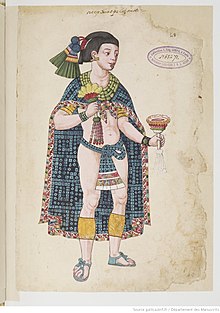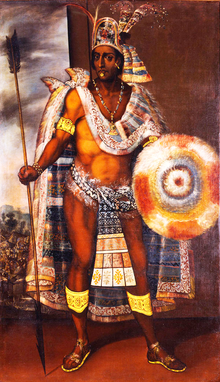Tlatoani
| Tlahtoāni of the Aztec Empire | |
|---|---|
 Sacred War emblem | |
| Details | |
| Style | Huēyi tlahtoāni |
| First monarch | Acamapichtli |
| Last monarch | Cuauhtémoc |
| Formation | c. 1376 |
| Abolition | 1521 |
| Residence | Tenochtitlan |
| Appointer | Council of Elders |
Tlatoani (Classical Nahuatl: tlahtoāni pronounced [t͡ɬaʔtoˈaːni] (![]() listen), "one who speaks, ruler"; plural tlahtohqueh [t͡ɬaʔˈtoʔkeʔ] or tlatoque) is the Classical Nahuatl term for the ruler of an āltepētl, a pre-Hispanic state. It can be translated to English as "king," and Huey Tlatoani is translated as "emperor."[1] A cihuātlahtoāni (Nahuatl pronunciation: [siwaːt͡ɬaʔtoˈaːni] (
listen), "one who speaks, ruler"; plural tlahtohqueh [t͡ɬaʔˈtoʔkeʔ] or tlatoque) is the Classical Nahuatl term for the ruler of an āltepētl, a pre-Hispanic state. It can be translated to English as "king," and Huey Tlatoani is translated as "emperor."[1] A cihuātlahtoāni (Nahuatl pronunciation: [siwaːt͡ɬaʔtoˈaːni] (![]() listen)) is a female ruler, or queen regnant.[2]
listen)) is a female ruler, or queen regnant.[2]
The term cuauhtlatoani refers to "vice-leader."[3] The leaders of the Mexica prior to their settlement are sometimes referred to as cuauhtlatoque, as well as colonial rulers who were not descended from the ruling dynasty.
The ruler's lands were called tlahtohcātlālli [t͡ɬaʔtoʔkaːˈt͡ɬaːlːi] (![]() listen), and the ruler's house was called tlahtohcācalli [t͡ɬaʔtoʔkaːˈkalːi] (
listen), and the ruler's house was called tlahtohcācalli [t͡ɬaʔtoʔkaːˈkalːi] (![]() listen)[4]
listen)[4]
The city-states of the Aztec Empire each had their own thatoani, or leader. He would be the high priest and military leader for his city-state and would be considered its commander-in-chief. The tlatoani was the ultimate owner of all land in his city-state and received tribute, oversaw markets and temples, led the military, and resolved judicial disputes.[5] He would often be a descendant of the royal family, but in some cases, he would be elected.[6] Since the Tlatoani was allowed to have several wives, his legacy would be easily maintained. After being established as the tlatoani, he would be the tlatoani of his region for life. The tlatoani was chosen by a council of elders, nobles, and priests, which would select from a pool of four candidates.
Commanding hierarchy[]

The cihuacōātl was the second in command after the tlatoani, was a member of the nobility, served as the supreme judge for the court system, appointed all lower court judges, and handled the financial affairs of the altepetl.[5]
Tlatoani during times of war[]
During times of war, the tlatoani would be in charge of creating battle plans, and making strategies for his army. He would draft these plans after receiving information from various scouts, messengers, and spies who were sent out to an enemy altepetl (city-state). Detailed information was presented to him from those reports to be able to construct a layout of the enemy. This was essential because this ensured the safety and success of each battle.
These layouts would be heavily detailed from city structures to surrounding area. The Tlatoani would be the most informed about any conflict and would be the primary decision maker during war. In modern terms, in the US, the Tlatoani would be the commander-in-chief, which is the president of the United States. The commander-in-chief is responsible for the armed forces or a military branch by exercising commands that must be followed.[7]
He would also be in charge of gaining support from allied rulers by sending gifts and emissaries from his city-state. During warfare the tlatoani would be informed immediately of deaths and captures of his warriors. He would also be in charge of informing his citizens about fallen or captive warriors, and would present gifts to the successful ones.
Tlatoque of the Aztec Empire[]

There were eleven tlatoque during the 145-year Aztec Empire.
- Acamapichtli: 1376–1395
- Huitzilihuitl: 1395–1417
- Chimalpopoca: 1417–1427
- Itzcoatl: 1427–1440
- Moctezuma I: 1440–1469
- Axayacatl: 1469–1481
- Tizoc: 1481–1486
- Ahuitzotl: 1486–1502
- Moctezuma II: 1502–1520
- Cuitláhuac: 1520
- Cuauhtémoc: 1520–1521
See also[]
- Aztec Emperors family tree
- Aztec Empire
- List of Texcoco rulers
- List of Tlatelolco rulers
- Emperor
References[]
- ^ Lockhart (2001, p.238); Schroeder (2007, p.3). See also the entry for "TLAHTOANI" Archived 2007-06-14 at the Wayback Machine, in Wimmer (2006)
- ^ Schroeder (2007, pp.3–4). See also the entry for "CIHUATLAHTOANI" Archived 2007-06-08 at the Wayback Machine in Wimmer (2006).
- ^ Schroeder (1991, p. 188).
- ^ Nahuatl dictionary (1997). Wired humanities project. Retrieved January 1, 2012, from link
- ^ Jump up to: a b "Aztec Political Structure". Tarlton Law Library. Retrieved 10 March 2020.
- ^ "pre-Columbian civilizations". Encyclopædia Britannica. 2016-11-22. Retrieved 2017-05-22.
- ^ "Aztec and Maya Law". Tarlton Law Library. Retrieved 11 March 2020.
Sources[]
- Berdan, Frances F.; Richard E. Blanton; Elizabeth Hill Boone; Mary G. Hodge; Michael E. Smith; Emily Umberger (1996). Aztec Imperial Strategies. Washington, DC: Dumbarton Oaks Research Library and Collection. ISBN 0-88402-211-0. OCLC 27035231.
- Gibson, Charles (1964). The Aztecs Under Spanish Rule: A History of the Indians of the Valley of Mexico, 1519–1810 (Reprinted 1976 ed.). Stanford, CA: Stanford University Press. ISBN 0-8047-0196-2. OCLC 190295.
- Lockhart, James (2001). Nahuatl as Written: Lessons in Older Written Nahuatl, with Copious Examples and Texts. UCLA Latin American studies, vol. 88; Nahuatl studies series, no. 6. Stanford and Los Angeles: Stanford University Press and UCLA Latin American Center Publications. ISBN 0-8047-4282-0. OCLC 46858459. (in English and Nahuatl languages)
- Schroeder, Susan (1991). Chimalpahin and the Kingdoms of Chalco. Tucson: University of Arizona Press. ISBN 0-8165-1182-9. OCLC 21976206.
- Schroeder, Susan (2007). "The Annals of Chimalpahin" (PDF). In James Lockhart; Lisa Sousa; Stephanie Wood (eds.). Sources and Methods for the Study of Postconquest Mesoamerican Ethnohistory (PDF e-book online publication) (Provisional version ed.). Eugene: University of Oregon Wired Humanities Project. Retrieved 2008-05-16.
- Wimmer, Alexis (2006). "Dictionnaire de la langue nahuatl classique" (online version, incorporating reproductions from Dictionnaire de la langue nahuatl ou mexicaine [1885], by Rémi Siméon). (in French and Nahuatl languages)
Further reading[]
- Carrasco, David. Daily Life of The Aztecs: People of the Sun and Earth. Connecticut: Greenwood Press, 1998.
- Sahagun, Bernardino de. Florentine Codex: General History of the Things of New Spain. Translated and edited by Arthur J. O. Anderson and Charles E. Dibble. 13 vols. Santa Fe: School of American Research, and University of Utah, 1950-1982.
- Somervill, Barbara A. Great Empires of the Past: Empire of the Aztecs. New York: Chelsa House, 2010.
- Tlatoque
- Aztec nobility
- Aztec society
- Cihuatlatoque
- Royalty in the Americas
- Royal titles
- Titles and offices of Native American leaders
- Nahuatl words and phrases
- Monarchy
- Aztec Empire